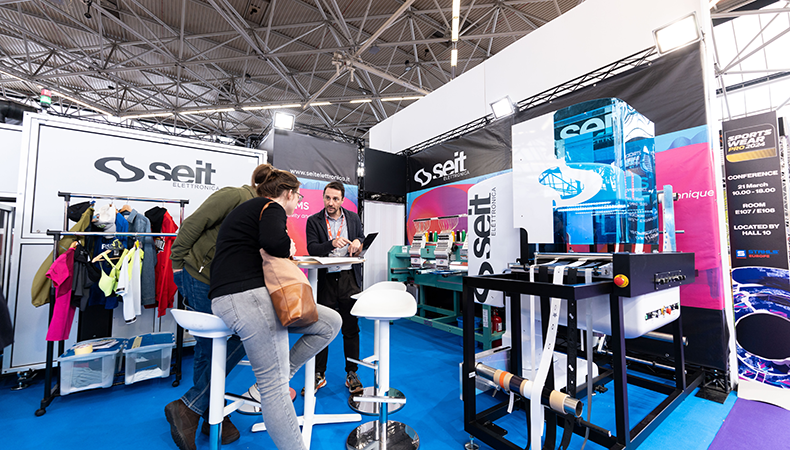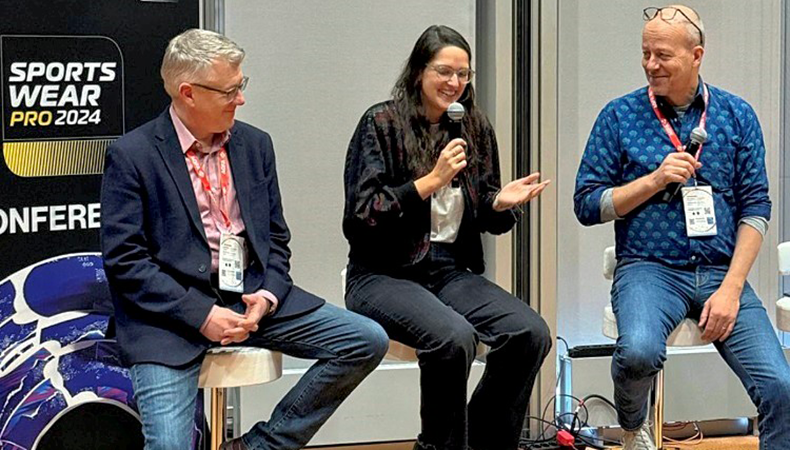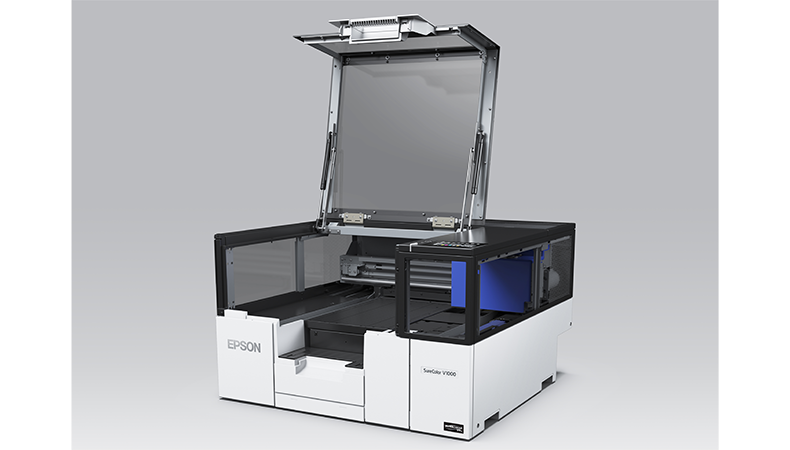Sportswear Pro: building ‘Brand Me’

After the success of the inaugural Sportswear Pro last month, we spoke with panellist and personalisation expert James Lawrence-Jones about the most exciting revelations at the event.
Technological advancements in the sportswear/personalisation market
A growing number of technology solution providers (such as MediaClip, Antigro and Kit Builder) are increasing competition in that space – in turn, this is driving innovation and the rapid development of new products and customer solutions. That’s beneficial for the customer, whether you’re a brand or an individual looking to get into this market, and for production houses looking to fulfil to that market.
The key benefit is that this is all pushing innovation forward and decreasing the cost of adoption. There are now intuitive, easy-to-use customer-facing design tools, as well as confidence-inspiring 3D previews, and supported ‘creative tools’ for customers so that they can design, review, and purchase truly unique, personalised sportswear and athleisure wear on demand.
Technology is delivering the capability to offer sports teams and individuals much more than a vinyl name and a number heat-pressed on the back of a stock generic shirt. Now customers can have a truly made-to-measure shirt with uniquely designed full coverage, full-colour printed garment made on demand.
This technology is also connected to an increasing number of e-commerce sales channels. Many custom product-building solutions are now enabled for and available to small independent online companies and Etsy individual crafters to offer those personalised sports and athletic leisure wear products.
 James Lawrence-Jones
James Lawrence-Jones
Artificial intelligence (AI) is also expanding creativity through chat-prompted image generation, as well as pattern generation and artwork tiling, repeating, mirroring and so on. The use of AI in artwork creation and design is enabling anyone too become an individual designer of ‘Brand Me’. Additionally, AI is now being used to optimise production and productivity, delivering job batching and imposition benefits.
Machinery producting personalised textiles and sportswear continues to evolve and innovate with an ever-increasing range of machines designed to meet all capacity and quality requirements. Production machines are increasingly green-button operation systems, potentially reducing the requirements for skilled operators. In addition, the solutions provided by the companies such as Antigro and others are delivering a pre-imposed, pre-optimised, print-ready file in the appropriate colour space and format straight to production without the need for additional skilled artworkers or print-ready files from customer orders.
Increased customer expectations
Ultimately, customer expectation is being driven by the technology that surrounds them day to day. The market potential for customised or personalised on-demand sportswear is growing, because the customer expectation or the desire to have those items is increasing. That’s being driven by the influencer generation and the social media platforms that encourage people to share about themselves and to be seen – in particular, wanting to be seen as unique, original and special.
Consumers are demanding more self-branded or one-off items in their wardrobes and broader lives. Social media technology and the success of early adoper brands in offering personalised fashion are changing the behaviour and the desires of the consumer to be seen, and to be seen as unique.
It’s clear that some of the brands that have engaged with this are now seen as trendsetters. They have created a model for personalisation in sportswear and in wider athleisure and fashion that is in turn driving customer demand. So, the likes of Vans, Nike, Burton Snowboards and Under Armour have all implemented creative innovation labs that customers use to access fully personalised clothing or footwear at a premium price. Brands can test and learn about their customer’s level of interest in personalisation affordably through creative design challenges of the type offered by IdealFactory and others.
Key trends
First, and most importantly, customer engagement with the idea of a unique personalised garment is driving demand. In addition, the rise of the co-lab and capsule collections in fashion is making one-off items the most desirable for Gen Z and the influencer generations.
Customers are also demanding a reduced carbon footprint from products that they buy and the companies they buy from. Historically the fashion industry has been one of the largest manufacturing polluters, with huge amounts of water use and chemical use, and wastage of unsold stock items. There’s a clear positive message in personalisation and print on demand: “We have only made what you wanted, with zero waste.”

It’s also clear, from the wider personalisation industry, that the personal connection a customer has with a unique product means that it’s far less likely to be considered disposable fashion: it has ‘emotional durability’. It will be treasured and repaired and have a long-use life.
AI, and the prevalence of 3D previews, is an important trend. You can not only design and 3D render your finished product using AI, but you can virtually try it on using AI using your face on an exact body-size virtual model and have it walk around in your design. AI not only provides creative design support, enabling anybody to be a skilled designer as they build their ‘Brand Me’ products, but also for buyers to have the confidence that the finished product will fit and look great, building buyer confidence and improving conversion rates.
Supply chain changes
There has been a clear environmental shift to drive transparency focusing on circularity, traceability and compliance across fashion and sportswear. This means increasing paperwork and process requirements on the back of the incoming EU legislation. The EU greenwashing ban was approved in January, so unsubstantiated marketing claims around being environmentally friendly or biodegradable will be policed far more closely and ultimately outlawed.
Standards around durability, recyclability, circularity and footprint reporting are in the process of being agreed. Digital product passports and labelling are clearly coming, if not already required. The hope is that if you’re producing a personalised product, as a manufacturer you have that information to hand. And even if a product has had specific fabrics and materials selected by the consumer, you can build that digital product passport very easily.
Businesses such as Printful or Gooten are connecting a growing global network of international third-party production fulfilment partners. Brands, companies and e-commerce businesses can now make use of a network of pre-vetted, pre-approved white label production partners with the appropriate sustainability paperwork already in place that they can nearshore their production to and speed up production times to customers. The use of pre-approved white label outsource production partners further minimises the complexity and cost for brands to start offering their customers personalised products.
Sustainability: a top priority
There was a great phrase used at the event. It’s no longer ‘design, make, sell’. Now it’s ‘design, sell, make’. That changes the whole supply chain dynamic. We no longer have to stockpile all the colours in all the sizes in all the designs in every store. We’re enabling a customer to pick and edit a product pattern or design for their item to be printed once.
 James Lawrence Jones (left) at Sportswear Pro with Serena Bonomi and Richard Askam
James Lawrence Jones (left) at Sportswear Pro with Serena Bonomi and Richard Askam
What was clear from Sportswear Pro is that now you can limit overproduction and sampling. You decrease returns through 3D previews and AI try-ons. And a personalised approach leads to an increased emotional connection and a longer use-life.
Some interesting questions subsequently arise: does personalisation of a garment limit the ability for it to be handed down, given to a charity shop and reused by somebody for whom that personalisation doesn’t have the same impact? Is it possible that a digital product passport indicating a ‘second life’ of a garment could become a badge of honour that the item has been reused? Can you ‘re-personalise’ the product again?
We are seeing a trend reverting back to handmade tailoring and made to measure, and away from wasteful, off-the-peg mass production. Ultimately, the industry has shown through the early adopters that you can charge a clear premium for a personalised item. While you may not have the volume of people buying a £10 disposable t-shirt, actually, if you’re selling half as many, but at two or three times the price, there may well be the same kind of margin for brands but with the added benefit of sustainability credentials and increased social media coverage.
Sportswear Pro highlights

Epson’s SC-V1000 A4 flatbed UV printer
Kornit’s 3D and lenticular effects were very strong. I saw probably half a dozen rotary UV printers, so there is obviously some growth in that area. Agfa and EFI’s strategic partnership, and the potential expansion of range for those two brands is interesting.
For me, the most impressive production device at the show was Epson’s A4 UV machine. Ideally suited to in-store retail personalisation and for the small crafter personalisation business, the small footprint of these UV printers is going to be transformative for the industry, in terms of price, but also the service agreement offered. In terms of software solutions and technology, I thought the Antigro Sticker Builder functionality provided cutting-edge intuitive tools producing an easily understandable product of personalised stickers.
James Lawrence-Jones is an independent consultant advising on print, personalisation and photography. He has more than 30 years’ experience across these industries – most recently he worked at Albelli-Photobox Group for 15 years in a variety of senior operations roles, most recently as Group Technical Innovation and QHSS Director. As a consultant, he shares the experience he gained and his industry expertise to ensure his clients avoid the pitfalls encountered during the rapid international growth and development of the Photobox Group, which grew from 300 staff to almost 2,000 during his tenure there. Contact him at james@lawrence-jones.com
Become a FESPA member to continue reading
To read more and access exclusive content on the Club FESPA portal, please contact your Local Association. If you are not a current member, please enquire here. If there is no FESPA Association in your country, you can join FESPA Direct. Once you become a FESPA member, you can gain access to the Club FESPA Portal.
Recent news

Regulation guidance: Corporate Sustainability Reporting Directive
The Corporate Sustainability Reporting Directive (CSRD) is now in effect, but with further changes on the horizon, what does it mean for printers? Sustainability consultant Rachel England outlines everything you need to know and talks to Apigraf about how your business may be affected.

Web-to-print design: Canva versus Kittl
We look at popular design packages Canva and Kittl to determine how they compare regarding graphic design and print on demand.

FESPA in South Africa: the print skills to thrive
Printing SA’s Career Day inspired young Cape Town learners to explore printing and packaging careers.

The rise of Chinese printers
Chinese printing companies are on the rise, and have their eyes set on the UK and EU marketplace. Some have made an instant impact; others are running into issues with maintenance and language barriers. What does the future hold for Chinese printing firms, and how can you navigate working with them?